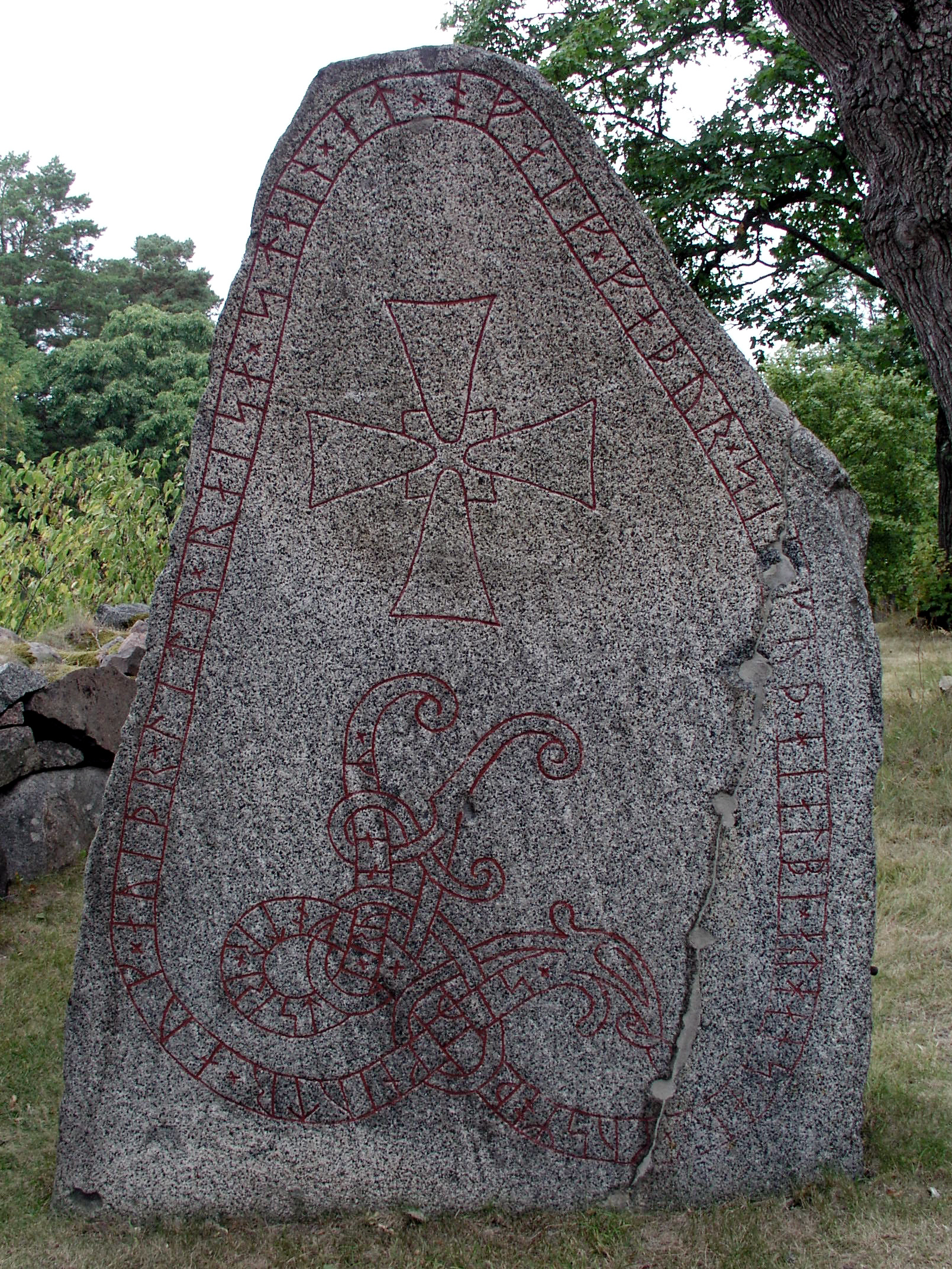|
Uppland Rune Inscriptions 101, 143 And 147
The runestones known as U 101 is located in Sollentuna, and U 143 and U 147 are located in Täby; all three are in Uppland, Sweden. They are all in the style Pr4 and thus dated to the period 1060-1100 during which they were carved in connection with the construction of a road from Hagby to Ed at Edsviken. They belong to a group of c. 20 runestones called the Jarlabanke Runestones that are connected to the local chieftain Jarlabanke and his clan. Together with the Broby bro Runestones and the Hargs bro runic inscriptions these particular runestones, however, centre on the female matriarch of the clan called Estrid, who was the grandmother of Jarlabanke. The runemaster of the Snottsta runestone called U 329, where an Estrid and her brother Ragnfast are mentioned, was Fot who also made the runestones for the Jarlabanke clan. This strongly suggests that Estrid was born in Snottsta (also spelled Snåttsta), married Östen of Täby and married for the second time in Harg near Snottst ... [...More Info...] [...Related Items...] OR: [Wikipedia] [Google] [Baidu] |
U 101, Södersätra
U or u, is the twenty-first and sixth-to-last letter and fifth vowel letter of the Latin alphabet, used in the modern English alphabet, the alphabets of other western European languages and others worldwide. Its name in English is ''u'' (pronounced ), plural ''ues''. History U derives from the Semitic waw, as does F, and later, Y, W, and V. Its oldest ancestor goes to Egyptian hieroglyphics, and is probably from a hieroglyph of a mace or fowl, representing the sound v.html"_;"title="Voiced_labiodental_fricative.html"_;"title="nowiki/>Voiced_labiodental_fricative">v">Voiced_labiodental_fricative.html"_;"title="nowiki/>Voiced_labiodental_fricative">vor_the_sound_[Voiced_labial–velar_approximant.html" ;"title="Voiced_labiodental_fricative">v.html" ;"title="Voiced_labiodental_fricative.html" ;"title="nowiki/>Voiced labiodental fricative">v">Voiced_labiodental_fricative.html" ;"title="nowiki/>Voiced labiodental fricative">vor the sound [Voiced labial–velar approximant" ... [...More Info...] [...Related Items...] OR: [Wikipedia] [Google] [Baidu] |
Estrid
{{For, the name Estrid, Astrid (name) Estrid (Old Norse: ''Æstriðr'', ''Ástríðr'') was a rich and powerful 11th-century Swedish woman whose long family saga has been recorded on five or six runestones in Uppland, Sweden. This Estrid was the maternal grandmother of the chieftain Jarlabanke of the Jarlabanke clan. The family were rich landowners and belonged to the higher echelons of Swedish society, and she was probably named after Estrid of the Obotrites, who was the queen of Sweden, and the consort of Olof Skötkonung, at the time Estrid was born. Her family saga has been the centre of a dramatisation at the Stockholm County Museum. It is safe to assume that five of the 11 runestones that mention an Estrid in eastern Svealand refer to this Estrid because of the locations of the runestones and the people who are mentioned on them. A sixth runestone, U 329, U 329: ''Inga had these stones raised in memory of Ragnfastr, her husbandman. He was Gyríðr's and Ástríðr's brothe ... [...More Info...] [...Related Items...] OR: [Wikipedia] [Google] [Baidu] |
Old Norse
Old Norse, Old Nordic, or Old Scandinavian, is a stage of development of North Germanic languages, North Germanic dialects before their final divergence into separate Nordic languages. Old Norse was spoken by inhabitants of Scandinavia and their Viking expansion, overseas settlements and chronologically coincides with the Viking Age, the Christianization of Scandinavia and the consolidation of Scandinavian kingdoms from about the 7th to the 15th centuries. The Proto-Norse language developed into Old Norse by the 8th century, and Old Norse began to develop into the modern North Germanic languages in the mid-to-late 14th century, ending the language phase known as Old Norse. These dates, however, are not absolute, since written Old Norse is found well into the 15th century. Old Norse was divided into three dialects: Old West Norse, ''Old West Norse'' or ''Old West Nordic'' (often referred to as ''Old Norse''), Old East Norse, ''Old East Norse'' or ''Old East Nordic'', and ''Ol ... [...More Info...] [...Related Items...] OR: [Wikipedia] [Google] [Baidu] |
Personal Pronoun
Personal pronouns are pronouns that are associated primarily with a particular grammatical person – first person (as ''I''), second person (as ''you''), or third person (as ''he'', ''she'', ''it'', ''they''). Personal pronouns may also take different forms depending on number (usually singular or plural), grammatical or natural gender, case, and formality. The term "personal" is used here purely to signify the grammatical sense; personal pronouns are not limited to people and can also refer to animals and objects (as the English personal pronoun ''it'' usually does). The re-use in some languages of one personal pronoun to indicate a second personal pronoun with formality or social distance – commonly a second person plural to signify second person singular formal – is known as the T–V distinction, from the Latin pronouns and . Examples are the majestic plural in English and the use of in place of in French. For specific details of the personal pronouns used in the Eng ... [...More Info...] [...Related Items...] OR: [Wikipedia] [Google] [Baidu] |
U 147, Fjäturen
U or u, is the twenty-first and sixth-to-last letter and fifth vowel letter of the Latin alphabet, used in the modern English alphabet, the alphabets of other western European languages and others worldwide. Its name in English is ''u'' (pronounced ), plural ''ues''. History U derives from the Semitic waw, as does F, and later, Y, W, and V. Its oldest ancestor goes to Egyptian hieroglyphics, and is probably from a hieroglyph of a mace or fowl, representing the sound v.html"_;"title="Voiced_labiodental_fricative.html"_;"title="nowiki/>Voiced_labiodental_fricative">v">Voiced_labiodental_fricative.html"_;"title="nowiki/>Voiced_labiodental_fricative">vor_the_sound_[Voiced_labial–velar_approximant.html" ;"title="Voiced_labiodental_fricative">v.html" ;"title="Voiced_labiodental_fricative.html" ;"title="nowiki/>Voiced labiodental fricative">v">Voiced_labiodental_fricative.html" ;"title="nowiki/>Voiced labiodental fricative">vor the sound [Voiced labial–velar approximant" ... [...More Info...] [...Related Items...] OR: [Wikipedia] [Google] [Baidu] |
U 143, Hagby
U or u, is the twenty-first and sixth-to-last letter and fifth vowel letter of the Latin alphabet, used in the modern English alphabet, the alphabets of other western European languages and others worldwide. Its name in English is ''u'' (pronounced ), plural ''ues''. History U derives from the Semitic waw, as does F, and later, Y, W, and V. Its oldest ancestor goes to Egyptian hieroglyphics, and is probably from a hieroglyph of a mace or fowl, representing the sound v.html"_;"title="Voiced_labiodental_fricative.html"_;"title="nowiki/>Voiced_labiodental_fricative">v">Voiced_labiodental_fricative.html"_;"title="nowiki/>Voiced_labiodental_fricative">vor_the_sound_[Voiced_labial–velar_approximant.html" ;"title="Voiced_labiodental_fricative">v.html" ;"title="Voiced_labiodental_fricative.html" ;"title="nowiki/>Voiced labiodental fricative">v">Voiced_labiodental_fricative.html" ;"title="nowiki/>Voiced labiodental fricative">vor the sound [Voiced labial–velar approximant" ... [...More Info...] [...Related Items...] OR: [Wikipedia] [Google] [Baidu] |
U 101, Closeup, Södersätra
U or u, is the twenty-first and sixth-to-last letter and fifth vowel letter of the Latin alphabet, used in the modern English alphabet, the alphabets of other western European languages and others worldwide. Its name in English is ''u'' (pronounced ), plural ''ues''. History U derives from the Semitic waw, as does F, and later, Y, W, and V. Its oldest ancestor goes to Egyptian hieroglyphics, and is probably from a hieroglyph of a mace or fowl, representing the sound v.html"_;"title="Voiced_labiodental_fricative.html"_;"title="nowiki/>Voiced_labiodental_fricative">v">Voiced_labiodental_fricative.html"_;"title="nowiki/>Voiced_labiodental_fricative">vor_the_sound_[Voiced_labial–velar_approximant.html" ;"title="Voiced_labiodental_fricative">v.html" ;"title="Voiced_labiodental_fricative.html" ;"title="nowiki/>Voiced labiodental fricative">v">Voiced_labiodental_fricative.html" ;"title="nowiki/>Voiced labiodental fricative">vor the sound [Voiced labial–velar approximant" ... [...More Info...] [...Related Items...] OR: [Wikipedia] [Google] [Baidu] |
Stockholm County Museum
Stockholm County Museum ( sv, Stockholms läns museum) is the regional museum of Stockholm County, Sweden. The museum's head office is currently located at Flemingsberg in Huddinge Municipality. Previously, the museum was located at Sickla. The museum serves the inhabitants in the county, especially those living in districts without a local museum. It documents both pre-historical and historical structures in the county and promotes people to visit historical locations by arranging "cultural paths" binding these sites together. To invite people to learn about the history of the county, the museum has put a large amount of texts and historical images on-line.Stockholm County Museum, English summary It also offers information on how to preserve old buildings and promotes the use of traditional materials when restoring historical structures.Stockholm County Museum - ''Byggwebben'' The museum attempts to put focus on the modern history of Stockholm, including its suburbs The ... [...More Info...] [...Related Items...] OR: [Wikipedia] [Google] [Baidu] |
Fot (runemaster)
Fot (Old Norse: ''Fotr'') was a runemaster who flourished in mid-11th century Sweden. Career Most early medieval Scandinavians were probably literate in runes, and most people probably carved messages on pieces of bone and wood.Vilka kunde rista runor?'' on the Swedish National Heritage Board website, retrieved January 13 2007. However, it was difficult to make runestones, and in order to master it one also needed to be a stonemason. During the 11th century, when most runestones were raised, there were a few professional runemasters. Fot was active as a runemaster in southern Uppland during the late Viking Age. His work is representative of the runestone style known as the Urnes style. This runestone style is characterized by slim and stylized animals that are interwoven into tight patterns. The animal heads are typically seen in profile with slender almond-shaped eyes and upwardly curled appendages on the noses and the necks. Fot is prominent among the known runemasters as ... [...More Info...] [...Related Items...] OR: [Wikipedia] [Google] [Baidu] |
Snottsta And Vreta Stones
The Snottsta and Vreta stones are individual runestones known as U 329, U 330, U 331 and U 332. They are found on the homesteads of Snottsta (also spelled Snåttsta) and Vreta, and they tell in Old Norse with the younger futhark about the family story of Gerlög and Inga in 11th century Uppland, Sweden, together with the Hillersjö stone (U 29) and the runestone U 20/21. The inscriptions are classified as being carved in the runestone style Pr3, which suggests that they were carved in the period 1050–1080. They were carved first, then U 20/21, and last Gerlög's Hillersjö stone. The four runestones say that Ragnfast, Inga's husband has died. Ragnfast was the sole inheritor of the homestead Snottsta after his father Sigfast. The runestone standing at Vreta gives the central information "she inherited her child". This statement agrees with what is said on the Hillersjö stone (U 29), which is that Inga inherited her son, a son who was not named, probably because he was very you ... [...More Info...] [...Related Items...] OR: [Wikipedia] [Google] [Baidu] |
Runemaster
A runemaster or runecarver is a specialist in making runestones. Description More than 100 names of runemasters are known from Viking Age Sweden with most of them from 11th-century eastern Svealand.The article ''Runristare'' in ''Nationalencyklopedin'' (1995). Many anonymous runestones have more or less securely been attributed to these runemasters. During the 11th century, when most runestones were raised, there were a few professional runemasters. They and their apprentices were contracted to make runestones and when the work was finished, they sometimes signed the stone with the name of the runemaster. Many of the uncovered runic inscriptions have likely been completed by non-professional runecarvers for the practical purposes of burial rites or record-keeping. Due to the depictions of daily life, many of the nonprofessional runecarvers could have been anything from pirates to soldiers, merchants, or farmers. The layout of Scandinavian towns provided centers where craftspeople ... [...More Info...] [...Related Items...] OR: [Wikipedia] [Google] [Baidu] |
Hargs Bro Runic Inscriptions
{{main article, Jarlabanke Runestones The Hargs bro runic inscriptions, or U 309, U 310 and U 311, are 11th century Younger Futhark inscriptions in Old Norse on bedrock in Skånela Parish, Uppland, Sweden. #U 309, U 309 and #U 310, U 310 constitute a twin monument in the style Pr4 and they are thus dated to the period 1060–1100. They belong to a group of c. 20 runestones called the Jarlabanke Runestones that are connected to the local strongman Jarlabanke and his Norse clans, clan. Together with the Broby bro Runestones and the Uppland Rune Inscriptions 101, 143 and 147 these particular runestones, however, treat the female matriarch of the clan called Estrid. U 310 tells that Estrid had a husband named Ingvar, and he had a son prior to marrying Estrid, named Ragnvald Ingvarsson, Ragnvald who died. Estrid constructed a bridge, apparently a tradition in her family. U 309 mentions Sigvid, Ingvar and Jarlabanke in a way that suggests that they are Estrid's sons. This Jarlabanke i ... [...More Info...] [...Related Items...] OR: [Wikipedia] [Google] [Baidu] |





